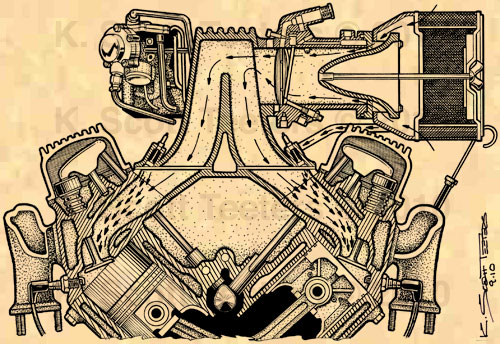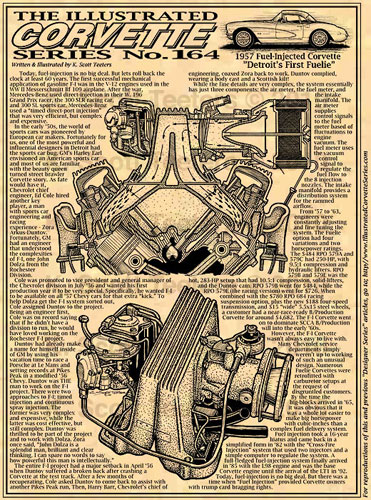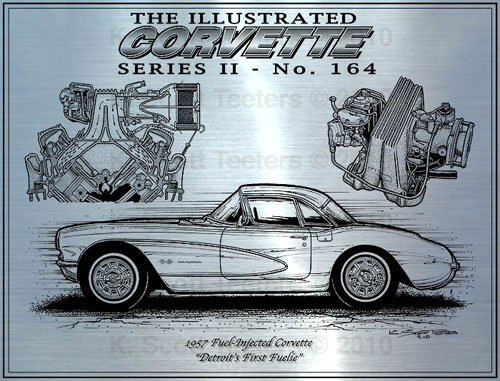An American Auto Exotic – ‘50s Style!
1957 Fuel-Injected Corvette – An American Classic
Today, fuel-injection is no big deal. But lets roll back the clock at least 60 years. The first successful mechanical application of gasoline F-I was in the V-12 engines used in the WW II Messerschmitt Bf 109 airplane. After the war, Mercedes-Benz used direct-injection in their W. 196 Grand Prix racer, the 300 SLR racing car, and 300 SL sports car. Mercedes-Benz used a “timed direct-port injection” that was very efficient, but complex and expensive.
In the early ‘50s, the world of sports cars was pioneered by European car makers. Fortunately for us, one of the most powerful and influential designers in Detroit had the sports car bug. GM’s Harley Earl envisioned an American sports car and most of us are familiar with the beauty queen turned street brawler Corvette story. As fate would have it, Chevrolet chief engineer, Ed Cole hired another key player, a man with sports car engineering and racing experience – Zora Arkus-Duntov. Fortunately, GM had an engineer that understood the complexities of F-I, one John Dolza from the Rochester Division.
Ed Cole was promoted to vice president and general manager of the Chevrolet division in July ‘56 and wanted his first production year to be very special. Specifically, he wanted F-I to be available on all ‘57 Chevy cars for that extra “kick.” To help Dolza get the F-I system sorted out, Cole assigned Duntov to the project. Being an engineer first, Cole was on record saying that if he didn’t have a division to run, he would have loved working on the Rochester F-I project.
Duntov had already make a name for himself inside of GM by using his vacation time to race a Porsche at Le Mans and setting records at Pikes Peak in a modified ‘56 Chevy. Duntov was THE man to work on the F-I project. There were two approaches to F-I; timed injection and continuous spray injection. The former was very complex and expensive, while the latter was cost effective, but still complex. Duntov was thrilled to be part of the project and to work with Dolza. Zora once said, “John Dolza is a splendid man, brilliant and clear thinking. I can spare no words to say how powerful this man is intellectually.”
The entire F-I project had a major setback in April ‘56 when Duntov suffered a broken back after crashing a Corvette at the test track. After a few months of recuperating, Cole asked Duntov to come back to assist with another Pikes Peak run, Then, Harry Barr, Chevrolet’s chief of engineering, coaxed Zora back to work. Duntov complied, wearing a body cast and a Scottish kilt!
There are numerous articles the fully explain “how” the system works. It’s very complex and an indicator of how smart the mechanical engineers that designed the system were.
While the fine details are very complex, the system essentially has just three components: the air meter, the fuel meter, and the intake manifold. The air meter supplies control signals to the fuel meter based of fluctuations to engine vacuum. The fuel meter uses the vacuum control signal to regulate the fuel flow to the 8 injection nozzles. The intake manifold provides a distribution system for the rammed airflow
From ‘57 to ‘63, engineers were constantly adjusting and fine tuning the system. The Fuelie option had four variations and two horsepower ratings. The $484 RPO 579A and 579C had 250-HP, with 9.5;1 compression and hydraulic lifters. RPO 579B and 579E was the hot, 283-HP setup that had 10.5:1 compression, solid-lifters, and the Duntov cam. RPO 579B went for $484, while the RPO 579E (the racing version) went for $726. When combined with the $780 RPO 684 racing suspension option, plus the new $188 four-speed transmission, and $15 “wide” 5.5×15 steel wheels, a customer had a near-race-ready B/Production Corvette for around $4,682. The F-I Corvette went on to dominate SCCA B/Production will into the early ‘60s.
The basic design of the mechanical fuelie setup was the same from ’57 to ’65, but in ’63 the plenum chamber was revised. In the final version release in ’64, the L84 Fuelie was rated at 375-HP.
However, the F-I Corvette wasn’t always easy to live with. Many Chevrolet service departments simply weren’t up to working of such an unusual design. Numerous Fuelie Corvettes were retrofitted with carburetor setups at the request of disgruntled customers. By the time the big-blocks arrived in ‘65, it was obvious that it was a whole lot easier to make big horsepower with cubic-inches than a complex fuel delivery system.
Fuel injection took a 16-year hiatus and came back in a simplified form in ‘82 with the “Cross-Fire Injection” system that used two injectors and a simple computer to regulate the system. A full-fledged fuel-injection system finally arrived in ‘85 with the L98 engine and was the base Corvette engine until the arrival of the LT1 in ‘92. Today, fuel-injection is no big deal. But there was a time when “Fuel Injection” provided Corvette owners with trump card bragging rights. – Scott
Prints of Illustrated Corvette Series No. 164 are available at… http://www.illustratedcorvetteseries.com/1957_Corvettes.html
And, we’re offering a Laser-Etched version too!






